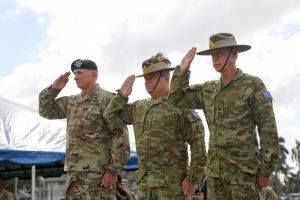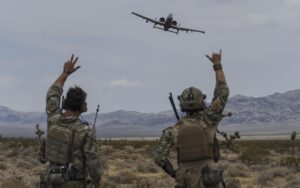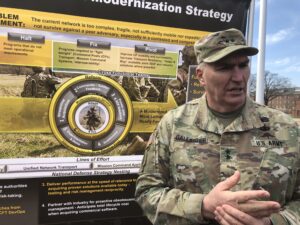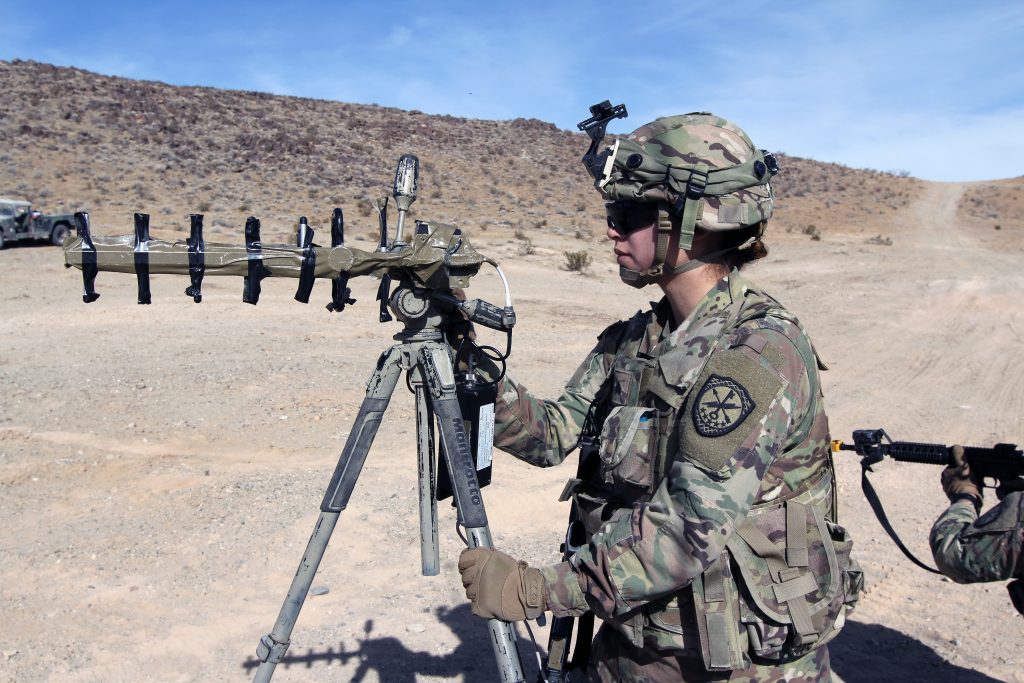By SYDNEY J. FREEDBERG JR
An Army soldier gets on his radio during exercises in Australia.
HUNTSVILLE: Working with Australia ought to be easy. It’s a longtime ally with a common language, shared traditions, and a lot of US-built technology and is a member of the Five Eyes. But when American artillerymen arrived in Oz for a recent exercise, the commander of US Army Pacific recounted, they discovered they couldn’t share data — not because of any technical problem, but because of an obscure policy on giving access to foreigners.
“Australia has AFATDS [Raytheon’s Advanced Field Artillery Tactical Data System] and we have it,” Gen. Robert Brown said. “We figured, ‘okay, that’s easy.’ Lo and behold, we get there and we realize there’s a policy that we can’t directly link with them, even though they have the same system we do and they’re an ally. We didn’t even know there was a policy!”
 Gen. Robert Brown (left), commander of the US Army Pacific, stands at attention with two Australian two-stars, Maj. Gen. Roger Noble (center) and Maj. Gen. Daniel McDaniel (right).
Gen. Robert Brown (left), commander of the US Army Pacific, stands at attention with two Australian two-stars, Maj. Gen. Roger Noble (center) and Maj. Gen. Daniel McDaniel (right).
Brown’s soldiers got a waiver to connect the artillery networks — “sometimes you’ve just got to ask” — but just asking was counter-cultural in an Army that’s long discouraged coloring outside the lines. You have to “push the system,” Brown said. “What we’d do for years was say, ‘we don’t have those authorities…. Policy says we can’t do that, so we can’t do that.’”
“One of the challenges is, we don’t know what polices to ask to be adjusted,” the general said, “because…. in some cases we’ve never tried to do some of this stuff, particularly in cyber and space.”
Yes, the Army fixed the problem with Australia, but Australia is about the easiest possible case. The Army network also faces some truly wicked problems too complex for human minds to manage — like threading jets, helicopters, missiles, and artillery shells through the same airspace without killing each other — which will force it to lean heavily on artificial intelligence.
It’ll be hard enough just to bring together data from across the Army and the other US services so all the Americans — let alone the allies — are on the same page. And that kind of Multi-Domain Command & Control (MDC2) is essential to Army and Air Force plans for future warfare, which seek to break down high-tech Russian and Chinese defenses with relentless, coordinated attacks from land, sea, air, space, and cyberspace.
“One of the thing’s that missing — and people are working it across the board — is a common operating picture,” Brown said. “How do you see all domains, without it just overwhelming you, [and] connect all those systems that were not designed to connect?”
“We’ve got to fight through the tendency to have a service solution only, a single-service solution, which is the way we grew up,” Brown told last week’s AUSA Globalconference here. “The good news is, we’re as joint as any force in the world. The bad news is, we’re still not joint enough.”
An American soldier (left) gets tips from a Polish ally (right) on how to aim an RPG during NATO anti-tank training.
“Secure But Unclassified”
The Army is urgently modernizing its internal networks already. Fed up with the long delays of military-unique development programs that are often obsolete on arrival, the service is increasingly turning to commercial, off-the-shelf technologies (COTS) and services — which should make it easier to get compatible systems with foreign allies.
Maj. Gen. Peter Gallagher briefs reporters on Army network modernization
The Army’s also made much of its tactical network “secure but unclassified.” That’s not solely for the allies’ benefit — rules for handling classified information are cumbersome even when only US soldiers are involved — but it does handily bypass restrictions on sharing classified data with foreign countries, making it easier to plug everyone in.
“We’ve got NSA approved encryption that allows the network to be secure, but we made a conscious decision… to operate unclass because we are operating with [foreign] partners,” said Maj. Gen. Peter Gallagher, head of the Army-wide network modernization team. Most data on the tactical network — unit locations, supply levels, orders for immediate action — will be out of date long before an adversary can decrypt it anyway, the Army believes.
Some network updates are being fielded now, but the next big upgrade will come in 2021, when the first “Capability Set” of the new Integrated Tactical Network (ITN) is issued to select infantry units. That will set off a two-year-cycle of overlapping major upgrades. In 2021, even as the first Capability Set is just entering service, the Army will be starting to test candidate systems for Capability Set ’23 and conducting early research and experimentation for CS ’25.
“If it’s not ready by’ 21, that’s fine… We’ll see you in ’23 — or maybe in between — if your capabilities are ready,” Maj. Gen. David Bassett, the Army’s Program Executive Officer for tactical networks, told contractors at the AUSA conference. “If it’s not, we need you to be honest about that.”
The Army “can’t solve the entire problem” in one go, Gallagher said, so it’s going step by step:
The 2021 upgrade will strive to simplify the network for small units and to slim down gear for easier deployment, especially in the Army’s Expeditionary Signal Battalions, Gallagher said.
2023 will focus on upgrading the network backbone with heavy use of new satellite constellations in Low and Medium Earth Orbit (LEO and MEO).
The hope for 2025 is that artificial intelligence and machine learning will have matured enough to build “self-forming” and “self-healing” networks that automatically connect sensors, decision-makers, and shooters across the force. This will require a major shift from self-contained nodes to cloud computing.
Finally, the 2027 update is supposed to fully support Multi-Domain Operations in time for the Army to field a full MDO “force package” — able to defeat Russia or China, but not both at once — by 2028.
As the Army network takes on increasingly complex problems over the next decade, it will have to lean ever more heavily on AI.
An Army cyber/EW soldier sets up an antenna during exercises at the National Training Center on Fort Irwin, Calif.
Big Army, Big Data
Traditionally, amateurs talk strategy while professionals talk logistics — but today, the professionals are increasingly talking data. Maintaining a modern war machine requires huge amounts of information, from ammunition supply levels to missile flight paths. That’s why the entire US military is keenly interested in big data analysis and machine learning, which requires lots of raw data for the AI algorithms to train on.
“For artificial intelligence and machine learning ….we see an immediate impact for the fielded force, not some 10, 15, 20 years out,” said Chip Retzlaff, chief of information management for Training & Doctrine Command’s intelligence section.
Consider the National Training Center, where Army brigades wage bloodless battles across the California desert in what’s basically the world’s biggest game of laser tag. Almost every soldier, vehicle, and weapon in these exercises is instrumented, and there’s years of data available to analyze, Retzlaff enthused. While training data is only an imperfect representation of actual battle, he acknowledged, machine learning algorithms could crunch the NTC data for use in training simulations or even planning aides for real-life operations.
Air Force JTACs (Joint Terminal Attack Controllers) wave to an A-10 during training for close air support.
 Another high-complexity, high-payoff application for AI, Reztlaff said, is airspace deconfliction. For the military, this means much more than air traffic control. A battle can involve Air Force, Navy, or Marine Corps jets — some of them dropping bombs or launching missiles — roaring through the same airspace as slower helicopters (mostly but not all Army), as well as drones, surface-to-surface missiles, missile defense interceptors, anti-aircraft weapons, and even artillery shells. The traditional solution is to reserve certain altitudes and areas for a particular service or even an individual unit, making them no-go for everyone else. But multi-domain operations require much greater flexibility and closer cooperation. What if an AI could track each object in flight, predict flight paths and issue warnings or even commands to change course as necessary?
Another high-complexity, high-payoff application for AI, Reztlaff said, is airspace deconfliction. For the military, this means much more than air traffic control. A battle can involve Air Force, Navy, or Marine Corps jets — some of them dropping bombs or launching missiles — roaring through the same airspace as slower helicopters (mostly but not all Army), as well as drones, surface-to-surface missiles, missile defense interceptors, anti-aircraft weapons, and even artillery shells. The traditional solution is to reserve certain altitudes and areas for a particular service or even an individual unit, making them no-go for everyone else. But multi-domain operations require much greater flexibility and closer cooperation. What if an AI could track each object in flight, predict flight paths and issue warnings or even commands to change course as necessary?
“Every system flying in the air today has telemetry data associated with it that can be offloaded” for analysis, Retzlaff said. That’s the big data foundation for future AI.
Airspace management, planning aides, and other unglamorous applications like predictive maintenance might lack the apocalyptic sex appeal of robot tanks and Terminators. But US officers have no intention of handing over control of lethal force to AI, as much as they want to enlist its help.
AI won’t replace human soldiers, Gen Brown emphasized: “The key is going to be artificial intelligence that helps human beings make decisions faster, that will weed through those haystacks of information and find you the golden needle.”




No comments:
Post a Comment